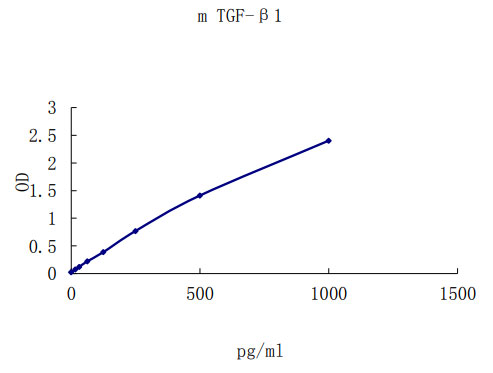Product Detail
Product NameMouse TGF-β1 ELISA kit
ApplicationsELISA
Species ReactivityMs
SpecificityNatural and recombinant Mouse TGF-β1 Ligand
Target NameMouse TGF-β1
Application Details
Detect Range: 0.03 - 2.0 ng/mL
Sensitivity: 15pg/mL
Sample Type: Cell culture supernatant, serum, plasma (EDTA, citrate, heparin)
Sample Volume: 20 uL
Assay Time: 3 hour
Detection method: Colorimetric
Transforming Growth Factor-beta (TGF-β) is a pleiotropic cytokine which exists in five isoforms, known as TGF-β1-5. TGF-β1 is the most abundant form in lymphoid organs and is found almost ubiquitously while other isoforms are expressed in a more restricted distribution. The biologically active forms of all isoforms are disulfide-linked homodimers. The heat- and acid- stable monomeric subunits have a length of 112 amino acids. TGF-β1 is produced in very high levels by platelets. Other cellular sources of TGF-β1 include macrophages, lymphocytes, endothelial cells, chondrocytes, and leukemic cells. TGF-β1 secretion can be induced by steroids, retinoids, EGF, NGF, vitamin D3, and IL-1. Activities of TGF-β1 include inhibition of cell growth for inhibitor for normal and transformed epithelial cells, endothelial cells, fibroblasts, neurons, and lymphoid cells and other hematopoietic cell types. TGF-β1 inhibits the proliferation of T cells and NK cells and down-regulates the activities of activated macrophages. TGF-β1 blocks the anti-tumor activity of IL-2-bearing lymphokine-activated killer (LAK) cells. TGF-β1 has a critical role in the development of regulatory T cells. Dendritic cells exposed to tumors have been reported to secrete TGF-β1 and stimulate expansion of naturally-occurring T reg cells. Moreover, TGF-β1 has been shown to act as a costimulatory factor for expression of Foxp3, leading to the differentiation of CD4+CD25+ Treg cells from peripheral CD4+CD25- progeny. TGF-β-induced regulatory T cells have been termed Ti-Treg.
If you have published an article using product EK0506, please notify us so that we can cite your literature.
et al,Melanin inspired microcapsules delivering immune metabolites for hepatic fibrosis management In Mater Today Bio On2023 Jun 24byXin Zhao , Zun Fan et al..PMID:37545558
, (2023),
PMID:
37545558
et al,Multifunctional manganese-based nanogels catalyze immune energy metabolism to promote bone repair
, (2025),
PMID:



 YES
YES



